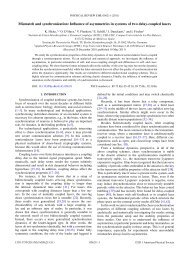DBI Analysis of Open String Bound States on Non-compact D-branes
DBI Analysis of Open String Bound States on Non-compact D-branes
DBI Analysis of Open String Bound States on Non-compact D-branes
Create successful ePaper yourself
Turn your PDF publications into a flip-book with our unique Google optimized e-Paper software.
CHAPTER 2. BOSONIC STRINGS 24from which the claimed result follows. Note that Eq. 2.8 shows that the c<strong>on</strong>formalweight <str<strong>on</strong>g>of</str<strong>on</strong>g> the fields X µ is zero, and hence in this case the result follows even withoutthe use <str<strong>on</strong>g>of</str<strong>on</strong>g> the equati<strong>on</strong>s <str<strong>on</strong>g>of</str<strong>on</strong>g> moti<strong>on</strong>.As was menti<strong>on</strong>ed earlier, the equati<strong>on</strong>s <str<strong>on</strong>g>of</str<strong>on</strong>g> moti<strong>on</strong> for h αβ , resulting in T αβ , can beused to show the classical equivalence between the NG and Polyakov acti<strong>on</strong>s. First,using Eqs. 2.60 and 2.61, remark that− det(∂ α X · ∂ β X) = − 1 ) 2(h4 h γδ ∂ γ X · ∂ δ X⇓√− det(g µν (X) ∂ α X µ ∂ β X ν ) = 1 √ ( )−h h γδ ∂ γ X · ∂ δ X . (2.65)2Plugging this result right into Eq. 2.5 immediatly gives back Eq. 2.1.In c<strong>on</strong>formal gauge, the c<strong>on</strong>straint equati<strong>on</strong>s readand in light c<strong>on</strong>e coordinates they translate toT 01 = T 10 = Ẋ · X′ = 0, (2.66)T 00 = T 11 = 1 2 (Ẋ2 + X ′2) = 0, (2.67)T ++ = ∂ + X µ ∂ + X µ = 0, (2.68)T −− = ∂ − X µ ∂ − X µ = 0, (2.69)T +− = T −+ = 0. (2.70)This last c<strong>on</strong>diti<strong>on</strong> expresses the vanishing <str<strong>on</strong>g>of</str<strong>on</strong>g> the trace in light-c<strong>on</strong>e gauge, η αβ T αβ =0 = T +− + T −+ .Virasoro generatorsInserting our mode expansi<strong>on</strong>s for X µ for the closed string into the above expresi<strong>on</strong> forT ++ , we find thatT ++ = ∂ + X L · ∂ + X L( +∞) (∑∑ +∞= ls2 ˜α me µ −2im(σ+ ) ·= l 2 s= l 2 sm=−∞( +∞∑+∞∑m=−∞ n=−∞+∞∑( +∞∑m=−∞ n=−∞n=−∞)˜α m · ˜α n e −2i(n+m)(σ+ ))˜α m−n · ˜α n e −2i(m)(σ+ ))˜α ne µ −2in(σ+ )where in the last step, we made use <str<strong>on</strong>g>of</str<strong>on</strong>g> the fact that the summing index runs over aninfinite range <str<strong>on</strong>g>of</str<strong>on</strong>g> values. The computati<strong>on</strong> for T −− is strictly analogous, and thus we see
















